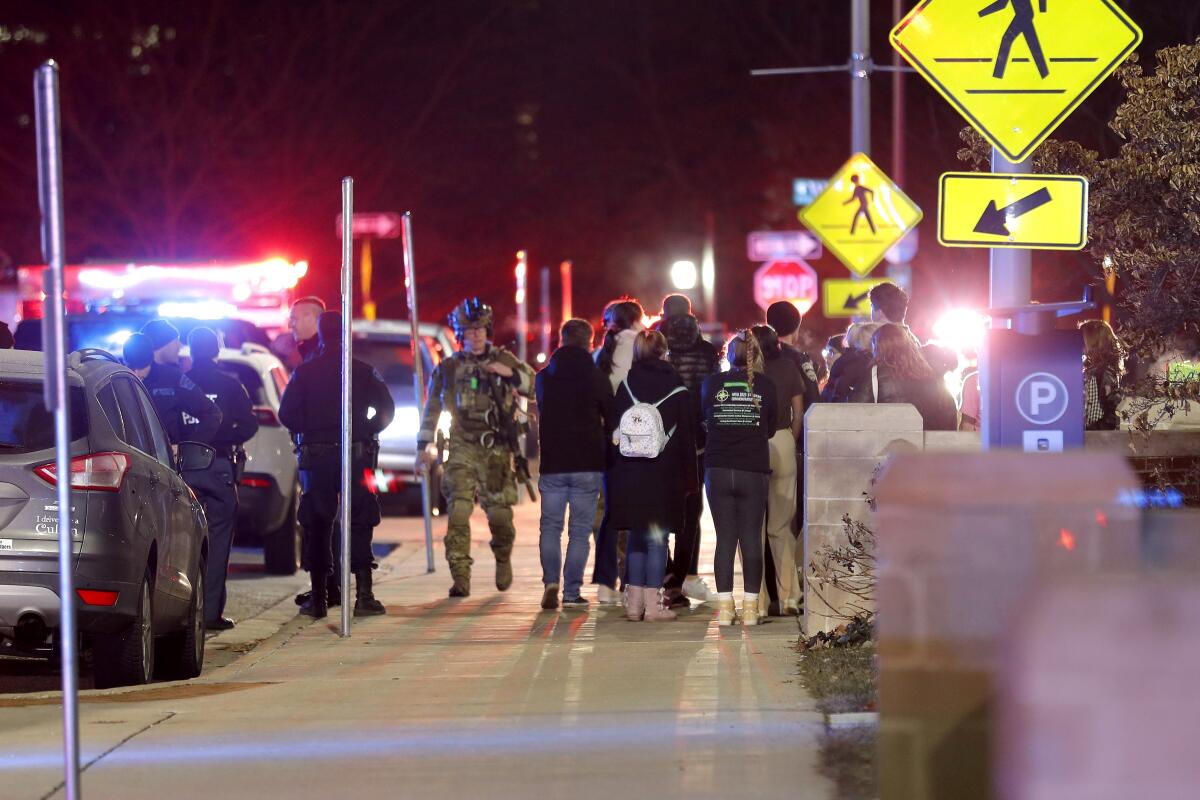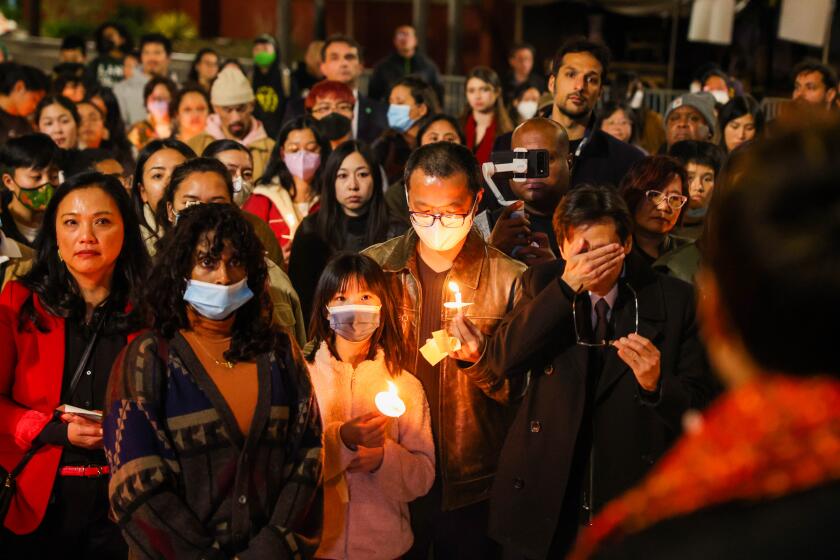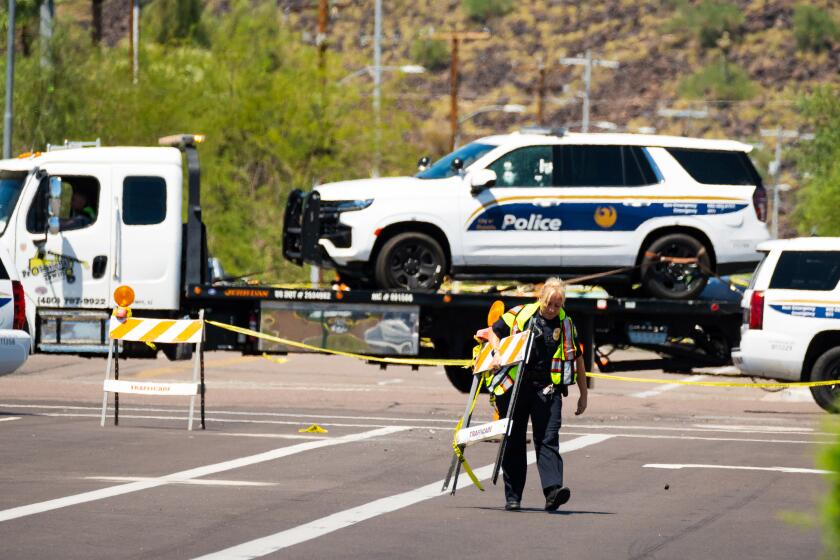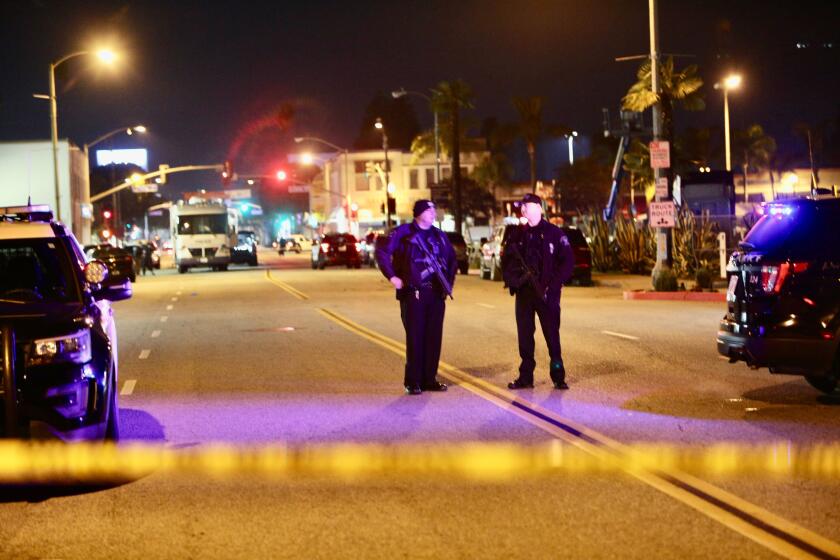How California’s colleges prepare for active shooters

- Share via
The video starts with a simple white background and a phrase that is all too recognizable to American college students: “RUN. HIDE. FIGHT.”
It’s part of a tool distributed by California State University to prepare students and employees for the possibility of an active shooter on one of its 23 campuses. These directions to run, hide and fight were also sent in text alerts Monday night to thousands of students, staff and others within the campus community at Michigan State University after a gunman opened fire, killing three students and injuring five others.
In the aftermath of this most recent college shooting, students expressed horror but not shock — having grown up as part of a generation that experiences gun violence with haunting regularity.
Preparing for an active shooter at colleges has been a regular part of safety planning for nearly two decades in California — home to the nation’s largest systems of public higher education and a state that has experienced its share of campus tragedies.
In 2014, seven people died during a shooting in Isla Vista, near the UC Santa Barbara campus. In 2016, a UCLA professor was fatally shot in his office by a former doctoral student. At Cal State Fullerton in 1976, seven people were killed by a custodian who stormed the library.
Across the University of California, all 10 campuses have worked to improve safety by upgrading technology, enhancing training and adding unarmed security officers, mental health professionals and other resources to supplement their sworn police forces, said UC Davis Police Chief Joseph Farrow, coordinator of the UC Council of Police Chiefs. He added that police at UC and CSU work together and generally use the same practices, protocols and training.
Police are still searching for a motive in the shooting deaths of three students at Michigan State University by a gunman who later killed himself.
“We’ve been dealing with this over our head for decades now,” said Scot Willey, acting police chief at Cal State Fullerton. “We don’t really want to think that could happen here, but we know that it did happen here.”
Here is more about how California’s colleges prepare for that possibility.
What are colleges required to do to protect students?
Under the Clery Act, a federal law enacted in 1990 and expanded since then, each time a school is notified of a campus crime, an official must review the crime and decide if it represents a “serious or ongoing” threat. All higher-education institutions — public and private — that receive money for federal student aid programs are required by law to follow the Clery Act.
If the threat is deemed serious or ongoing, the school must issue a timely warning to the entire campus.
Colleges and universities must also establish and put into effect emergency responses and notification systems. They must inform the school community about any “significant emergency or dangerous situations involving an immediate threat to the health or safety of students or employees on the campus.” That includes shootings, fires, earthquakes and crimes of sexual violence.
Campus police agencies are required to have a rapid response plan for mass shootings, said Melinda Latas, director of campus safety compliance for CSU. Those plans, which are posted to school websites, detail how authorities manage the first response in a shooting and how campuses must train for them.
The federal law was named for Jeanne Clery, a first-year student at Lehigh University in Pennsylvania, who in 1986 was sexually assaulted and killed in her dorm room by another student she did not know.
Gun violence has become the drumbeat of our days. We say we’re shocked, but we’re really not. We say we’re in disbelief, yet we’re really not.
When did colleges begin to prepare for mass shootings?
The Virginia Tech mass shooting in 2007, which left 32 people dead, changed the way colleges handle mass shootings and crime emergencies, according to John Ojeisekhoba, president of the International Assn. of Campus Law Enforcement Administrators.
“Prior to Virginia Tech, I remember very clearly, a lot of colleges — the mindset was that it can’t happen here,” said Ojeisekhoba, who is also an associate vice president at Biola University. “After Virginia Tech, the pendulum swung to ... ‘It can actually happen to my campus. We’re not immune.’”
Schools invested in resources to identify and assess threats and in training campus and community members to prepare for a shooting. Ojeisekhoba said having police officers on campus is not enough — schools must conduct training with local and federal agencies to simulate the emergency response.
What does training look like?
Training is critically important, for both security officers and the wider community, campus security experts said.
Cal State Fullerton holds an active shooter drill every two years in specific locations on campus, such as a parking structure or the student union, Willey said.
Over the summer, the university trains about 200 students on run, hide, fight procedures. During one drill, Willey said, a police officer is dressed in a padded suit while carrying a rubber rifle. Students are taught where to run and locations that are good for hiding. They’re also taught to use items around them — staplers, laptops, iPads — to fend off an attacker if there are no other options.
At UC Davis, students are given training on active shooter situations during required orientations; the workshops are also available to all campus members.
Four high-profile shootings in U.S. cities this week drew headlines but masked the daily toll of gun violence in some of the same communities.
Students are taught to silence their cellphones, although it helps officers when people message about what is happening in their part of campus, as first responders are sometimes “going in blind,” Farrow said.
But it’s not easy to reach everyone with training. Campus populations are huge — UC Davis has more than 60,000 students, faculty and staff.
This month, Biola plans to conduct an active shooter exercise with the Orange County Sheriff’s Department, the Whittier Police Department and the Los Angeles County Fire Department.
What security challenges do open campuses present?
Unlike K-12 schools, public college campuses are not gated, with access open to anyone.
“You don’t know everybody that comes on your campus,” Farrow said. “That’s the disadvantage that you have, and that’s what they experienced in Michigan State.”
When police receive the first reports of a shooter on campus, the protocols are generally consistent across universities, Farrow said. The dispatchers write up a notification that an active shooter is present, giving a location if known, and urge people to leave the area or shelter in place. This is automatically sent to the entire campus community and to parents and families who have signed up for such notifications, Farrow said.
But it doesn’t always work smoothly.
In 2019, Officer Natalie Corona of the Davis Police Department was shot and killed after responding to reports of a car crash a few feet from the campus. Witnesses said the shooter ran into the campus — an erroneous report that prompted UC Davis to issue the active shooter notification. But the notification was delayed for some people — an issue also reported last year at UCLA when a former lecturer allegedly sent campus members a video referencing a mass shooting.
Farrow said UC Davis officials discovered a technical flaw in the software, fixed it and now test the system regularly.
Eleven people are dead after a man opened fire in a dance studio in Monterey Park. Police believe the shooter also targeted an Alhambra studio. Here’s what we know.
How has the technology evolved?
Improvements to technology, including enhanced door-locking systems and closed-circuit cameras that help authorities identify potential shooters, have helped campuses to be better prepared.
Ojeisekhoba said notification systems that allow campuses to send out mass alerts are mandatory for all higher-education institutions.
At Cal State Fullerton, police can consult hundreds of surveillance cameras throughout the campus, Willey said. The school can blast “shelter in place” warnings over indoor and outdoor speakers, along with sending email and text alerts.
“Text is the most efficient thing that we can use and probably the quickest way that we can communicate with our community,” he said.
Under UC Davis Chancellor Gary May, the campus launched a $12-million, five-year plan to enhance security with such technology as an automatic door-locking system, allowing officials to close all buildings simultaneously rather than having to use individual keys.
UC Davis also has added a sophisticated camera system that monitors public access. Other U.S. campuses have invested in “shot spotter” devices that detect gunshots and quickly identify where they are coming from, Farrow said.
UC Davis has added 25 unarmed security officers to its safety staff of 49 sworn police officers and 90 students. The officers help patrol the campus, check building locks and escort students to classes and dorms when requested; some are trained to take down crime reports.
Similar steps are being taken throughout the UC system as President Michael V. Drake has led efforts to reshape campus safety practices by supplementing the traditional reliance on sworn police officers.
“One thing all chancellors say is that we have to keep these open campuses as safe as we can,” Farrow said.
More to Read
Sign up for Essential California
The most important California stories and recommendations in your inbox every morning.
You may occasionally receive promotional content from the Los Angeles Times.

















